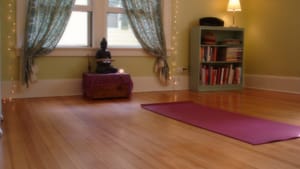Stay in the Loop
BSR publishes on a weekly schedule, with an email newsletter every Wednesday and Thursday morning. There’s no paywall, and subscribing is always free.
The priceless cost of peace of mind
A few words about ‘sacred spaces’

Forget the runway-sized granite countertops, home theaters and safe rooms. According to the Wall Street Journal (Oct. 11), the latest must-have amenity in luxury housing is a “sacred space.”
It seems that architects and builders are now designing Zen gardens, meditation rooms, yoga studios and private chapels for their highest-end clients. These privileged folks are willing to pay big bucks for in-house sanctuaries devoted to the pursuit of inner peace and expanded consciousness.
While there is a certain irony in spending $400,000 on a teahouse in which to contemplate non-material verities— as did one of the Journal article’s subjects— there is merit in creating a personal domestic refuge from the market-driven secularity of contemporary life. We all feel an innate desire to connect with something larger and more meaningful than the ego, and anything we can do to cultivate the serenity necessary to encourage that connection will help bring balance to our lives.
I once created a meditation space in an alcove of a master bedroom. A fortuitously located skylight beamed celestial illumination directly onto the zafu, where I sat observing my breath and antic thoughts. Having a designated place to practice Vipassana meditation helped me keep the world at bay and quell the chattering of my monkey mind so that I could occasionally experience a few nanoseconds of awe-inspiring nothingness.
If you must….
Out here in vortex-ridden Taos, where spiritual seeking is practically a requirement for residency, domestic sacred spaces are commonplace. They range from improvised altars set up on coffee tables or in wall niches to circular meditation rooms that resemble aboveground Native American kivas and backyard meditation labyrinths lined with boulders.
Obviously, creating a personal sacred space doesn’t require the services of an architect or contractor. But it does require an awareness of the defining characteristics of a sanctified place, whether it be a tiny wall niche or the formal structures of institutionalized spiritual traditions.
(1) A spatial demarcation established via some kind of physical boundary such as walls, or a change of level or material. A separate room is optimum, but a part of a room set off by a partial wall or a piece of furniture will work. As will a makeshift altar on a shelf, table or bench, or a prayer rug unfurled on a floor.
(2) Exclusivity. The space is utilized solely or primarily for spiritual pursuits; it isn’t “polluted” with items and activities of secular life. No dumping car keys and sunglasses on the altar; no muddy boots in the tea ceremony pergola.
(3) The presence of ritual objects that direct our focus to our own version of the divine. Icons, crosses, Buddha statues, crystals, river rocks, feathers…. whatever works to turn one’s attention to the voidness of the void, the Great Mother Goddess, the Holy Spirit, or however we may attempt to conceive of the unconceivable ground of existence.
(4) Cleanliness and order. A sacred space demands care and attention as a sign of respect. Dust bunnies and dead flies are inappropriate intrusions, and a haphazard arrangement of ritual objects obscures their significance. The symbolically most powerful object— say, a representation of one’s chosen deity— should be placed in a central position with items of tribute, candles, incense, and flowers around it.
My daily ritual
Of course, to the enlightened few, all space is sacred. If we can be here in the full power of now, to scramble the words of Ram Dass and Eckhart Tolle, there’s no division between sacred and profane. When our consciousness is sufficiently expanded, any space— be it St. Mark’s in Venice or the Lexington Avenue subway in New York— is sacred.
Designated sacred spaces— cathedrals, Zen gardens and domestic shrines— are simply the equivalent of exercise equipment: aids to help us stumble into moments of transcendence that can profoundly affect our most mundane experiences.
I’m hardly an enlightened being, but my monkey mind has quieted to an extent that I’ve replaced the alcove and zafu with a daily “coffee meditation.” That is, I stagger to the kitchen in the morning, grind some boutique-roaster beans and make a cup of industrial strength java in a French press. (This ritual by no means resembles a tea ceremony; at 7 a.m. I’m one of the Walking Asleep if not the Walking Dead.) Then I stagger back to bed, sit bolt upright with my chakras nicely aligned, and focus on the source of attention. (Subtle and elusive, but it works for me.)
The aromatic coffee, the sleeping Weimaraner on the duvet, the sunlight filtering in through the wooden shutters, my own aging aching body— they’re all good, all part of one miraculous divine continuum for which I’m profoundly grateful.
Sign up for our newsletter
All of the week's new articles, all in one place. Sign up for the free weekly BSR newsletters, and don't miss a conversation.

 Susan E. Washburn
Susan E. Washburn